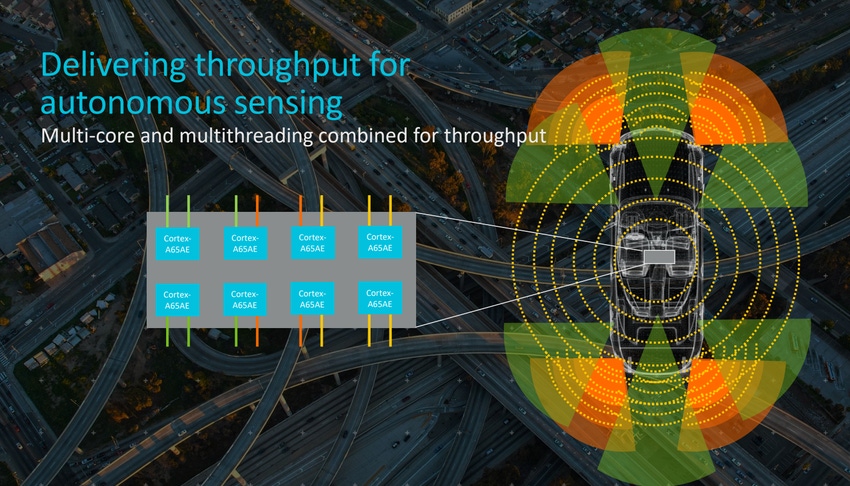Arm's Latest Autonomous Car Processor Targets Sensors and Safety
As the second addition to Arm's family of “automotive enhanced” processors, the A65AE is designed for handling the throughput and low-latency requirements inherent in autonomous vehicle sensors.
December 18, 2018

|
The Cortex-A65AE is a multicore processor with multithreading capabilities capable of handling the sensor processing historically done by several individual CPUs. (Image source: Arm) |
Back in September, Arm announced the Cortex-A76AE (automotive enhanced) processor designed for ensuring safety and efficiency in the systems running an autonomous vehicle.
Now, Arm has expanded its family of autonomous enhanced processors with the Cortex-A65AE, a multi-threaded CPU designed to handle the processing needs of autonomous vehicles at the sensor level. The new processor maintains the safety ready features touted in the A76. But while the A76 is targeted at higher level vehicle functions, the new A65 functions at the hardware level.
During a press briefing, Lakshmi Mandyam, VP of automotive at Arm, said Arm believes safety is going to be the number one challenge for OEMs producing self-driving cars and the consumers purchasing them. According to a May 2018 survey conducted by the American Automobile Association (AAA), concerns over autonomous vehicles have only been growing. As of April 2018, 73 percent of Americans surveyed reported being afraid to ride in a self-driving vehicle (up from 63 percent from a 2017 survey). Additionally, 63 percent of Americans surveyed said they would feel less safe walking or cycling knowing they are sharing the road with an autonomous car.
In the face of this, Mandyam said the question for engineers then becomes, “How do you deploy the innovation needed for autonomous processing in a manner that consumers can trust?” Autonomy will never be trusted until the processing is safe, she said, noting, “We're seeing a significant increase in the number of sensors needed to achieve these higher levels of autonomy...” This, in turn, is driving a significant increase in processing and throughput requirements to safely process this data.
RELATED ARTICLES:
And it's not just in terms of autonomous systems. New and immersive driver experiences and the evolving nature of the dashboard and infotainment center also facilitate a greater need for safer and more efficient processing. Having a sleek touchscreen-only dashboard, such as in the concept vehicles developed by Byton, is great—unless the processors running the interface aren't up to par. It's not difficult to imagine what sorts of hazards can happen if a driver spends too long looking at the dashboard because of slow processing. More latency with the dashboard means more time spent not watching the road.
This sort of safety issue becomes even more critical when you're talking about sensor data that will be identifying people, animals, and other dangerous obstacles on the road that a self-driving car must avoid. “Sensor processing is very high throughput, but has a high efficiency requirement with a minimum per thread performance,” Mandyam said.
“Historically, you would need a separate processor for each sensor stream to be able to deliver on the stringent throughput and latency requirements,” Mandyam said. But because the A65 is a multicore processor with multithreading capabilities, Mandyam said it can process up to two streams of sensor information per core. In other words, the work of dozens of separate CPUs can be handled by a fewer number of A65s, thus improving overall efficiency and latency.
Like the A76, the A65 is equipped with Arm's Split-Lock technology for enabling flexible processing for handling inputs from a variety of different sensors on the same processor. With Split-Lock, cores can be “split” so that cores handle instructions as they come for optimized speed and performance, “locked” so that two cores run the same instructions and each operation is checked, or some combination of the two. The locked features provide additional safety without added software complexity, according to Arm, and allow the A65 to conform to ISO26262 ASIL D safety standards.
Combining the A65 with the A76 is designed to give OEMs an optimum solution for handing the sensing, perception, and decision making functions in an autonomous vehicle. The A65 sits at the hardware end, handing sensor throughput. A combination of A65s and A76s can then handle the perception stage, with the A65 handling more of the throughput and the A76 taking on more of the compute power tasks, Mandyam said. And finally, the A76 handles the higher-level decision making systems.
|
OEMs can combine the A65 with the A76 to handle various levels of autonomous car functions, ranging from sensor processing to higher-level decision making. (Image source: Arm) |
The A65AE is only the latest in a planned roadmap for Arm's autonomous enhanced processors. Beginning in 2019, Arm is expected to announce two more processors for automotive: a future Cortex-R processor and another AE processor, codenamed “Hercules.”
Arm hasn't released any further information. Given the reputation of the Cortex-R, however, it is likely the new processor will target real-time, safety critical vehicle operations. The Hercules is a bit more mysterious, but there is perhaps some information built into its codename. The A65AE, which handles sensor input, was previously codenamed Helios, after the Greek god of the sun. Based on its codename, perhaps the Hercules will be focused on power management (another growing concern around autonomous vehicles) in some capacity.
Arm is expecting to release the first A56AE chips sometime in 2020.
|
Chris Wiltz is a Senior Editor at Design News covering emerging technologies including AI, VR/AR, and robotics.
About the Author(s)
You May Also Like




.jpg?width=300&auto=webp&quality=80&disable=upscale)

